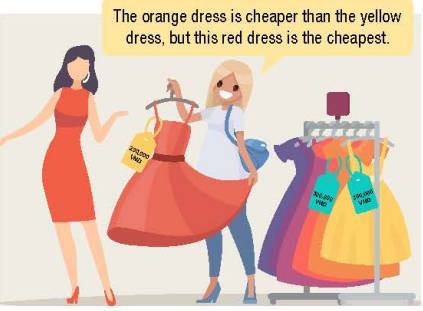Hãy nhập câu hỏi của bạn vào đây, nếu là tài khoản VIP, bạn sẽ được ưu tiên trả lời.

1. She isn’t cooking. She's eating.
(Cô ấy không nấu ăn. Cô ấy đang ăn.)
2. He isn’t reading. He’s sleeping.
(Anh ấy không đọc. Anh ây đang ngủ.)
3. They aren’t skateboarding. They’re reading.
(Họ không trượt ván. Họ đang đọc sách.)
4. It isn’t drinking water. It’s playing.
(Nó không đang uống nước. Nó đang chơi với một quả bóng.)
5. He isn’t washing. He’s cooking.
(Anh ấy không giặt đồ. Anh ấy đang nấu ăn.)
6. They aren’t playing volleyball. They’re chatting.
(Họ không chơi bóng chuyền. Họ đang trò chuyện.)

A. a dress, a coat, a hat and gloves.
B. a shirt, a tie, a jacket, and trousers.
C. a sweater/T-shirt, a cardigan, a skirt, a scarf and boots.
D. a T-shirt, a hoodle, shorts and trainers.

Marriage is an ancient religious and legal practice celebrated around the world. However, wedding customs vary from country to country.
The Wedding Dress: In many countries, it is customary for the bride to wear a white dress as a symbol of purity. The tradition of wearing a special white dress only for the wedding ceremony started around 150 years ago. Before that, most women could not afford to buy a dress that they would only wear once. Now, bridal dresses can be bought in a variety of styles. In some Asian countries and in the Middle East, colors of joy and happiness like red or orange other than white are worn by the bride or used as part of the wedding ceremony,
The Wedding Rings: In many cultures, couples exchange rings, usually made of golf or silver and worn on the third finger of the left or right hand, during the marriage ceremony. The circular shape of the ring is symbolic of the couple's eternal union. In Brazil, it is traditional to have the rings engraved with the bride's name on the groom’s ring, an vice versa.
Flowers: Flowers play an important role in most weddings. Roses are said to be the flowers of love, and because they usually bloom in June, this has become the most popular month for weddings in many countries. After the wedding ceremony, in many countries the bride throws her bouquet into a crowd of well-wishers – usually her single female friends. The person who catches this bouquet will be the next one to marry.
Gifts: In Chinese cultures, w edding guests give gifts of money to the newly-weds in small red envelopes. Money is also an appropriate gift at Korean and Japanese wedding. In many Western countries, for example in the U.K, wedding guests give the bride and groom household items that they may need for their new home. In Russia, rather than receiving gifts, the bride and groom provide gifts to their guests instead.
With the continued internationalization of the modern world, wedding customs that originated in one part of the world are crossing national boundaries and have been incorporated into marriage ceremonies in other countries.
111. Which of the following is the best title of the passage?
A. Wedding ceremoniesB. Wedding customsC. Wedding dayD. Wedding history
112. The tradition of wearing a special dress only on one’s wedding day is ____.
A. about 150 years agoB. over a century ago
C. less than 100 years agoD. less than 200 years ago
113. In some cultures, the bride wears a white dress as a traditional symbol of ____.
A. modestyB. secrecyC. purityD. security
114. In some Asian and Middle Eastern.countries, which colour is NOT considered to be suitable for a wedding?
A. redB. orangeC. whiteD. blue
115. The phrase “eternal union" in paragraph 3 is closest in meaning to____.
A. never-ending relationshipB. lovely relationship
C. temporary relationshipD. healthy relationship
116. The word “this" in paragraph 4 refers to which of the following?
A. roleB. loveC. JuneD. rose
117. According to the passage, in which country would the wedding guests give the bride and groom money as a present?
A. BrazilB. the U.KC. ChinaD. Russia
118. Which of the following information is TRUE according to the passage?
A. Nowadays, every bride can afford to buy a wedding dress to wear only once.
B. It is believed that any person who catches the bride’s bouquet will be the next to marry.
C . It is customary to write the groom's name on the bride’s wedding ring.
D. Thanks to globalization, one country’s wedding customs may be added to other countries’.

2. fireworks
3. costumes
4. decorate
5. celebrate
6. presents - party

Câu sai là: The Privacy Scarf is a scarf that you pull over your head and laptop.
=> Vì ngữ điệu câu đi lên ở cuối câu.

Học sinh tự thực hiện.